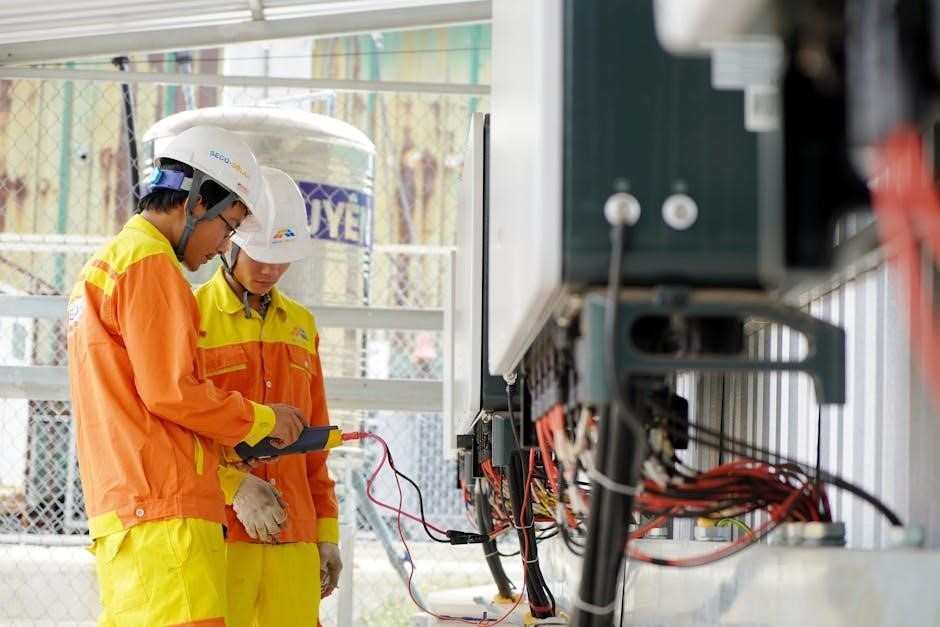The MOT testing guide provides information on vehicle inspection and testing procedures, including the inspection manual, for licensed testers and vehicle owners, using the latest guidelines and regulations available online now.
Overview of the Guide
The MOT testing guide and inspection manual is a comprehensive document that outlines the procedures and standards for conducting MOT tests on vehicles. The guide is intended to help licensed testers and vehicle owners understand the requirements for MOT testing, including the inspection procedures, testing standards, and documentation requirements. The guide is divided into sections, each covering a specific aspect of MOT testing, such as vehicle identification, brakes, steering, and electrical equipment. The guide also includes information on the latest changes to the MOT testing regulations and procedures, ensuring that testers and vehicle owners are up-to-date with the latest requirements. Additionally, the guide provides information on the role of the Driver and Vehicle Standards Agency (DVSA) in regulating MOT testing and the importance of complying with statutory requirements. The guide is an essential resource for anyone involved in MOT testing, providing a clear and concise overview of the testing process and requirements. The guide is available online, making it easily accessible to testers and vehicle owners. The guide is regularly updated to reflect changes in regulations and procedures.

MOT Inspection Manual Sections
The manual sections include vehicle inspection procedures and testing standards, using guidelines and regulations, with online information available now for testers.
Vehicle Identification and Inspection
The vehicle identification and inspection process is a crucial part of the MOT testing guide and inspection manual, ensuring that all vehicles are properly identified and inspected before being tested.
The inspection manual provides detailed information on the procedures to be followed, including the use of online resources and guidelines.
The vehicle inspection process involves checking the vehicle’s make, model, and Vehicle Identification Number (VIN), as well as its registration and other relevant details.
This information is used to verify the vehicle’s identity and ensure that it is eligible for testing.
The inspection process also involves checking the vehicle’s condition, including its tires, brakes, and other essential systems, to ensure that it is roadworthy and meets the required safety standards.
The MOT testing guide and inspection manual provide detailed information on the inspection process, including the use of specialized equipment and techniques.
The guide and manual are updated regularly to reflect changes in regulations and testing procedures, ensuring that testers have access to the most up-to-date information.
The vehicle identification and inspection process is an essential part of the MOT testing process, ensuring that all vehicles are properly tested and meet the required safety standards.

MOT Testing Procedures and Standards
Testing procedures and standards are outlined in the guide, including inspection and testing methods, using the latest online guidelines and regulations available now every day.
Class 1 and 2 MOT Tests
The MOT testing guide provides detailed information on Class 1 and 2 MOT tests, which cover motorbikes, scooters, mopeds, and motorbike combinations. The guide outlines the testing procedures and standards for these vehicles, including the inspection of brakes, steering, and suspension. The Class 1 MOT test is for motorbikes with an engine size of up to 200cc, while the Class 2 MOT test is for motorbikes with an engine size of over 200cc. The guide also provides information on the testing of other equipment, such as lamps, reflectors, and electrical equipment. Additionally, the guide covers the testing of body, structure, and attachments, as well as other safety-critical components. The testing procedures and standards outlined in the guide are designed to ensure that motorbikes and other vehicles are safe to use on public roads. By following the guide, testers can ensure that they are conducting MOT tests in accordance with the latest regulations and guidelines. The guide is an essential resource for anyone involved in MOT testing, including testers, examiners, and vehicle owners. The information provided is accurate and up-to-date.

Recent Changes to the MOT Inspection Manuals
Changes were published on 6th February 2023, updating the MOT inspection manuals and testing guide with new regulations and guidelines for testers and examiners to follow and implement correctly now.
The summary of changes to the MOT inspection manuals and testing guide provides an overview of the updates and revisions made to the documentation. The changes, which were published on 6th February 2023, aim to improve the clarity and consistency of the guidelines for testers and examiners. The updates include revisions to the inspection procedures, as well as changes to the standards and requirements for vehicle testing. The summary of changes is intended to help testers and examiners understand the updates and implement them correctly. The document outlines the key changes and provides information on how to access the updated manuals and guides. By reviewing the summary of changes, testers and examiners can ensure that they are familiar with the latest requirements and are able to conduct tests in accordance with the updated guidelines. The summary is an essential resource for anyone involved in MOT testing, and is available online for reference and download.

Compliance with Statutory Requirements
Compliance with statutory requirements is mandatory for MOT testing, using Motor Vehicles Regulations and guidelines for accurate testing and certification purposes only.
Authorisation by the Secretary of State
The authorisation by the Secretary of State is a critical aspect of the MOT testing guide and inspection manual, as it outlines the requirements for individuals and organisations to become authorised examiners and testers.
This authorisation is granted in accordance with the Motor Vehicles (Tests) Regulations 1981, as amended, and is a necessary step for those involved in MOT testing to ensure compliance with statutory requirements.
The Secretary of State’s authorisation process involves meeting specific criteria and guidelines, which are outlined in the MOT testing guide and inspection manual.
The guide provides detailed information on the application process, the requirements for authorisation, and the responsibilities of authorised examiners and testers.
By following the guidelines outlined in the MOT testing guide and inspection manual, individuals and organisations can ensure that they meet the necessary standards for authorisation by the Secretary of State.
The authorisation process is an important part of the MOT testing scheme, as it helps to maintain the integrity and accuracy of the testing process.
The MOT testing guide and inspection manual are essential resources for those involved in MOT testing, providing comprehensive information on the authorisation process and other aspects of MOT testing.
The guide is regularly updated to reflect changes in regulations and guidelines, ensuring that authorised examiners and testers have access to the most current information.
Overall, the authorisation by the Secretary of State is a critical component of the MOT testing scheme, and the MOT testing guide and inspection manual play a vital role in supporting this process.
The guide helps to ensure that MOT testing is carried out in a fair, accurate, and consistent manner, which is essential for maintaining road safety and reducing the risk of accidents.
By following the guidelines outlined in the MOT testing guide and inspection manual, individuals and organisations can help to maintain the high standards of the MOT testing scheme.
